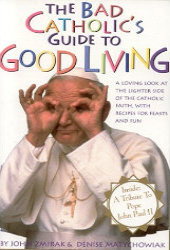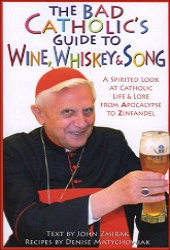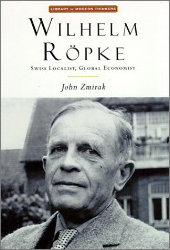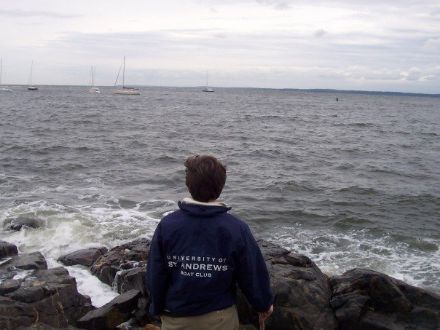People
About Andrew Cusack
 Writer, web designer, etc.; born in New York; educated in Argentina, Scotland, and South Africa; now based in London.
Writer, web designer, etc.; born in New York; educated in Argentina, Scotland, and South Africa; now based in London. read more
News
Blogs
Reviews & Periodicals
Arts & Design
World
France
Mitteleuropa
Knickerbockers
Argentina
The Levant
Africa
Cape of Good Hope
Netherlands
Scandinavia
Québec
India
Muscovy
Germany
Academica
Professor Haldane in the Catholic Herald

The Catholic Herald talks to Professor Haldane about the Church’s failure to halt the revolting HFE bill that recently passed (the one authorizing animal-human hybrids and the creation of human “saviour siblings” in labs for organ harvesting) and they have a nice picture of the Good Professor in his sitting room at St Andrews. Prof. & Mrs. Haldane were always very welcoming to students and had a whole bunch of us over a number of times. As I wrote before:
He has a library to be envied as well.
In my very first year at St Andrews, I had the privilege of shaking the hand of none other than Mr. James Macmillan (Greatest Living Scotsman!) at Professor Haldane’s. Certainly one to remember.
Mutton-chops

Woah! Look at the mutton-chops on our own James Poulos. Someone better bring the smelling salts for Mrs. P.. If only they had had blogging at the time of the Charlottetown Conference, I am certain Mr. Poulos would feel quite at home amongst the Fathers of the Canadian Confederation. Mutton-chops galore, up north yonder.
Fred Henzer
What can one say about Fred Henzer? Fred was a man of some contradictions. The very first time I ever met him, back in high school (it seems eons ago), he tried to beat the living daylights out of me because I had mistaken him for a particular enemy of his. Luckily for me he was restrained by his friends (indeed, my friends) who vouched for me and urged him to forget such an innocent error. I didn’t think much of him and made a mental note not to get involved with such a character. But of course it was hard not to come across Fred often if you were born in 1984 and hung around Bronxville. Our introductory incident was quickly forgotten and we soon became friends (though admittedly never close), mostly because we had friends in common.
Fred was charming without being a cad. It was no doubt why and how, despite his many flaws, he managed in those days to have a girlfriend as pretty and immediately endearing as Alana (who flew across the country to attend his funeral today — her birthday). And while his friends were his friends (and indeed being his friend was something that mattered to Fred), he did have his enemies as well — more out of pride and anger, I think, than out of a genuine hate.
He was an inveterate moocher. Of course the man whom he mooched off of the most was Frank Powers. Frank, without a doubt the most respected and admired man of those our age in Westchester, was probably the best friend he ever had, but as Frank said when once asked of Fred, there’s only so much you can do for a friend.
Fred found some of the slight restrictions the rest of us take for granted quite irritating, and sometimes he in turn became an irritation to others because of it. I remember once driving back from some party or gathering at 2:00 in the morning when we stopped at a red light. Sitting in the passenger seat, he found the red light unbearable and begged me to pass through it, there was no one behind us, nor in front of us, not a single car in sight, he pleaded. No one would notice, it wouldn’t hurt a fly, just run this light! But I was as stubborn as he, and it was not long before it turned green anyhow and he shut up.
But his flaws were always excused, weren’t they? He was Fred after all. In hindsight, there is an obvious and quick temptation to call ourselves to account for his ultimate downfall. Could we have done more for him? Were we too tolerant? Too forgiving? Couldn’t we have somehow intervened? I doubt it. Fred was his own master. He made his own decisions; he made good ones and he made poor ones, but they were his. As Frank (who would know more than anyone else) said, there’s only so much you can do.
His end did not come as a surprise to those who knew him, but this does not negate the tragedy of his death, and indeed his life. We must restrain ourselves from romanticizing the life and death of an addict. It was undignified. Fred was a human being — a son, a brother, a friend — he deserved better. It is saddening that someone as vivacious and lively and indeed loving as Fred did not have enough of that most necessary love, the love of life, to keep himself in order and his bad habits in check.
What has he left us in this world? Bits of laughter and hilarity, some very amusing times, moments of lightness and indeed even wit, too many to even attempt to record here. These may sound like light and ephemeral things, but there was an underlying goodness to Fred that animated them, and it is that underlying goodness that I hope we will all recall in years to come when our minds turn back to the man we used to know, Fred Henzer.
We will remember him.
1984-2008
Requiem aeternum dona eis Domine:
et lux perpetua luceat eis.
Requiescat in pace.
John Zmirak is “The Church’s Comedian”
Note: This was just sent me by a mutual friend of Herr Zmirak and myself. At first thought it was a wry parody of a ZENIT article but, lo and behold, it is actually a real ZENIT article praising this loyal son of the Empire State (who proudly boasts of his descent from subjects of the Hapsburgs).
Stand-up Apologist
John Zmirak Called to Be Church’s Comedian
by Elizabeth Lev
VATICAN CITY, APRIL 23, 2008 (Zenit.org).- In his 1980 novel “The Name of the Rose,” Umberto Eco dedicated a lengthy erudite section to the question, “Did Jesus Laugh?” Reading the works of Catholic author John Zmirak, he probably laughs a lot.
John Zmirak, a Queens-born author, journalist and apologist, regaled students and adults alike last week in Rome during the launch of his new book “The Grand Inquisitor.”
I spoke to Zmirak about how he reconciled a rapier wit with an ironclad faith, and was fascinated to hear the story of how this prickly pear of piety sprouted in the heart of 1970s Queens.
While other adolescents challenged authority by flaunting curfews or smoking, Zmirak was a youthful rebel for God. During his sophomore year, his religion teachers at his local Catholic high school began teaching notions contrary to the faith. Not being particularly well formed, Zmirak absorbed the doubts and contradictions until one day he was told that the transubstantiation — the change of bread and wine into the body and blood of Christ — wasn’t real.
The 15-year-old student balked, remembering vividly his mother explaining that when the bells rang “the bread turns into God.” (This by the way, is a reminder of the centrality of the role of parents in the formation of children.)
Zmirak found a Catechism and read the Church’s teaching for himself. Outraged, the teenager began a letter-writing campaign to his local bishop, persevering in the face of indifference and even hostility. One can almost imagine Zmirak as an early Christian martyr, proclaiming his faith and poking fun at his persecutors even as he faced the lions in the arena.
Zmirak’s unique perspectives and fine mind won him a scholarship at Yale, where he faced the full gale of secular intelligentsia. But he soon realized that it wasn’t the finely reasoned arguments against the tenets of Catholicism that were weakening the faithful, but ridicule.
Zmirak has an unusual take on what undermined the faith of Catholics in America. “It wasn’t eroded by earnest atheists and intellectual attacks,” he states. “What broke down ordinary people was a thousand clever comedic skits.”
So George Carlin and Saturday Night Live’s Father Guido Sarducci are responsible for the rise of the “cafeteria Catholics?” Zmirak says yes. “If you get people laughing, whatever your message is, it slides in unnoticed under the door.”
And thus Zmirak found his vocation. He thought that if humor could be used against the Church, then it could be used for it.
Two of the author’s most popular books are “The Bad Catholic’s Guide to Good Living” and “The Bad Catholic’s Guide to Wine, Whiskey and Song.” Like handbooks for fraternity boys, these books dream up parties, games and drinking activities, all laced with good humor and anchored in Catholic belief.
The good-living guide is dedicated to the fine sense of humor of the Pope John Paul II. Zmirak points out that the Pope not only brought down the Iron Curtain, but also won hearts with his refreshing comedic moments. Even a generation raised on Seinfeld and Monty Python found him accessible.
His guide follows the liturgical calendar with hilarious takes on the individual feasts and recipes and party ideas to celebrate them. In the pages of his book, every day is a reason to make merry in the Catholic world.
The “Guide to Wine, Whiskey and Song” is the rarest of things — a successful sequel. From A to Z, Zmirak runs through the most well-stocked liquor cabinet imaginable, tracing every form of spirit and elixir back to its Christian origin. In the finest of traditions, he also provides drinking songs, the funniest being Monty Python’s “Philosopher Song” reworked to feature heretics.
Zmirak’s latest effort, “The Grand Inquisitor” is a different genre for him, a graphic novel. Dubbed the anti-“Angels and Demons,” the story is set during a conclave, involves kidnapped cardinals, but champions the cause of orthodoxy and fidelity to the magisterium.
“The Grand Inquisitor” features all the staples of a good noir thriller — dark, graphic design, striking portraits and flashes of razor sharp wit — but contrary to genre which invariably transmits an anti-Christian message, Zmirak’s story is rooted in love for the Church.
After several days with John Zmirak, it became clear that a deep faith and great intelligence provide ballast for what seems to be Christendom’s first stand-up comic. A refreshing reminder of how it takes all kinds to make the Catholic Church.
Gadzooks!
 Tintin aficionados (such as your present scribe) have always had a certain nervousness with regards to putting the Belgian boy wonder on the big screen. Hergé’s creation is brilliant in the original comic books, acceptable in the 1990’s television cartoon version, but has produced only some thoroughly suspicious live-action film versions. (Namely, the 1961 “Tintin and the Golden Fleece” — not that Golden Fleece — and the 1964 “Tintin and the Blue Oranges”; neither of them based on books).
Tintin aficionados (such as your present scribe) have always had a certain nervousness with regards to putting the Belgian boy wonder on the big screen. Hergé’s creation is brilliant in the original comic books, acceptable in the 1990’s television cartoon version, but has produced only some thoroughly suspicious live-action film versions. (Namely, the 1961 “Tintin and the Golden Fleece” — not that Golden Fleece — and the 1964 “Tintin and the Blue Oranges”; neither of them based on books).
There was mention in the Economist some years ago of Spielberg doing a Tintin film and casting Leonardo diCaprio (!?!) in the lead role. I happened to cut it out of the Economist and so I have it somewhere amongst my clippings, but Hogarth claims his rheumatism and the current climate (“with respect, sir, wasn’t this humid before the war”) prevent him from classifying and filing my gigantic collection of clippings so I may have to wait until retirement to find it.
Word now comes, via the Guardian, that Herr Spielberg, fresh from his fourth and presumably final Indiana Jones adventure, is indeed to embark upon a Tintin film, and that he will cast the 17-year-old Briton Thomas Sangster as the heroic reporter. Cinephiles will recall Master Sangster from the 2003 Richard Curtis romantic-comedy “Love Actually” — which could have been a lovely, if typically sappy, film were it not for an entire subplot revolving around something rather lewd and not worthy of mention.
Unfortunately, my first reaction is that young Sangster is ill-suited for the role of Tintin. Firstly, he’s too young. I have always thought Tintin was permanently about 21, whereas Sangster will have just reach 18 when the film is in production. At a mere age of 18, can we really expect him to be undermining Bolshevism in the early Soviet Union? Or saving the ancient Syldavian monarchy from the threat of the dreaded Iron Guard? Or helping his pal General Alcazar regain the dictatorship of San Theodoros? I think not. But at 21, it seems much more possible.
(Of course, there are several more questions that any earnest Tintinophile feels compelled to ask. Will it be an adaptation or an original script? If an adaptation, of which book? Having a particular love of Scotland, I hope it’s The Black Island. Being a monarchist, I hope it’s the splendidly mitteleuropan King Ottokar’s Sceptre. But then perhaps, somewhat topically, they will choose Tintin in Tibet. And who will the rest of the cast be? Captain Haddock? Professor Calculus? Thompson and Thomson? Oh my…)
Well, we will just have to wait and see. After Herr Spielberg finishes his Tintin film, it appears that Peter Jackson (of “The Lord of the Rings” fame) will have a go at directing one himself. And there’s nothing to say he’ll use the same cast. Spielberg’s film is due in late 2009.
California Wedding
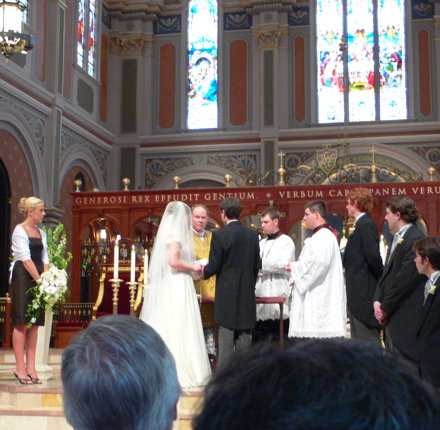
WHERE DOES ONE begin? Scotland, I suppose. I’ve known Abby since Day One in St Andrews. I was among the number of poor souls who were foolish enough to participate in the ‘overseas orientation’ for non-UK/RoI students. Through pure chance, a group of us who sat down to dinner in Andrew Melville Hall that night decided to venture into town that evening and see what was what. We went to the Central, which became my regular for a very long time, until replaced by the Russell for my tertian and magistrand years. Jon I met just over a year later, during his first few weeks at St Andrews (as I entered my second year). It was at the Catholic Society and he told me he came from Bristol. I was fairly ignorant of Bristol other than that it is home to the British Empire and Commonwealth Museum. I asked Jon about the museum and his answer was such as to confirm that he and I were on the same page of the book, so to speak. He didn’t come much to Canmore at the start and so we were not instant friends, though I do recall running into him in the corridor of New Hall at 2 or 3 in the morning one night and striking up a brief conversation (most likely telling him he ought to be coming to Canmore, since like-minded folk are a dime a dozen there).
Anyhow, by some time or another we were all best of friends, and both Jon and Abby have been the source of (and butt of) so many of the great amusements we enjoyed at St Andrews. Good God, how many laughs! In Canmore, the Cellar Bar, the Central, the Russell, in flats, in Edinburgh, in Rome, in Dublin, in New York, and most recently in California, whenever one is with Jon and Abby there is always a good time to be had, and an appropriately inappropriate comment to relish. I have picked up the habit of simply saying “ledge” (that is, short for “legend”) every time I utter the name of Jon Burke. Abby once desired that I verbally express precisely what it was that makes Jon such a legend, but all I could say was that it was of the same nature as the Sacraments in Eastern theology: appreciated, nourishing, and clung-to, but ultimately a mystery.
It was California then, which was host to our latest adventure, namely the joining in matrimony of Miss Abigail Hesser and Mr. Jonathan Burke. I flew in on Wednesday and upon checking in at the hotel, the desk clerk handed me a written message from Jon: “We’re in the bar, free cocktails!” The wonderful rehearsal dinner was the next evening, and I was privileged to have the best seat in the house, with Fr. E and Mrs. Hesser on my left and Abigail and Jon on my right. But Friday… Friday was the wedding! (more…)
Wedding Bells
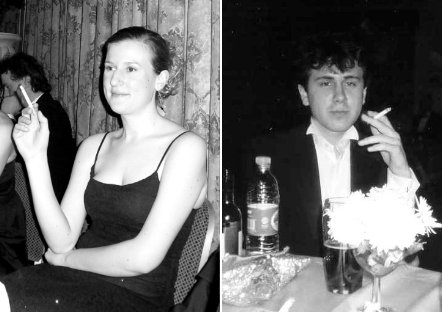
I’m off to California for a few days (I’ve never been before) for the wedding of two friends with whom some of the readers of this blog may be acquainted, Abigail Hesser & Jonathan Burke. It should prove quite good fun, and of course we certainly had a ball at the the last wedding. And it’ll be in the old rite as well!
A Happy Birthday to Her Majesty
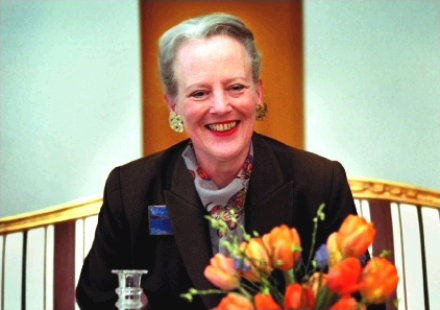

In honour of the anniversary of the birth of Her Majesty Queen Margrethe II of Denmark, I raised a glass of Warre’s (Purveyors to the Household of the Queen of Denmark) this evening. May God bless and keep Her Majesty!
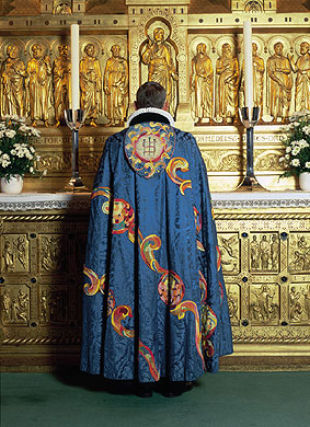
Some of you may recall that Her Majesty is of a somewhat artistic temperment. She sent her sketches inspired by The Lord of the Rings to J.R.R. Tolkein while he was alive, and the author liked them so much he had them published in the Danish edition of the trilogy. Above is an episcopal cope designed by Her Majesty in 1988 for the Cathedral of Viborg.

His Royal Highness Prince Christian, the Queen’s grandson and the future King of Denmark.
Naturally, we also wish a very happy birthday and many, many bountiful blessings to another of Christendom’s reigning monarchs: Christ’s vicar and our Holy Father, Pope Benedict XVI, who, it seems, is a reader of Chronicles. God bless our Pope, the great, the good!
Diary
THE RECENT UTTERANCE of most grievous blasphemies against the Holy Spirit and the Blessed Virgin by a member of Senator John Edwards’ presidential campaign team sparked great scandal, much compounded by the Senator standing by the offending party after the affair erupted. While she has since resigned, one wonders in what jurisdiction her comments, posted electronically on the internet, were made. Blasphemy remains a common law offense in New York, while one suspects it is almost as rarely enforced as those as-yet-unrepealed Plantagenet-era laws requiring all free-born Englishmen to practice archery weekly.
The blasphemy case which obtained the greatest reknown in these parts took place in December of 1810. A man (we will not call him gentle) by the name of Timothy Ruggles was brought to court in Salem in Charlotte County, New York. (Or, more properly, Washington County, as that particular bailiwick, originally named after the patron of the arts and Queen Consort to King George the Last, had been rechristened after a George of more recent popularity). Ruggles, anyhow, had made grievously blasphemous utterances against Our Lord and the Blessed Virgin which do not bear repeating (but which the inquisitive and hard-stomached scholar can find in the appropriate academic sources).
Ruggles had reckoned himself a “free thinker” and the townsfolk made haste to ensure he would be, at the very least, an imprisoned one. Found guilty in the Court of Oyer and Terminer of Salem, he was jailed for three months and fined $500. The blasphemer appealed the conviction, his lawyer arguing that there was no specific statute against blasphemy in the State of New York. The great James Kent, Chief Justice (and later Chancellor) of New York whose Commentaries on American Law earned him the worthy cognomen of “America’s Blackstone”, however, upheld the blasphemy conviction, citing blasphemy as a threat to morality and public welfare and “offence against the public peace and safety”. Would that such was the case today!
IN THE MIDST of the frigid cold, I found myself (a fortnight ago) having a meander around the old Ward estate in New Rochelle. I was very glad that I had brought my walking stick along, as most of the old paths were covered in frozen snow. Without the aid of it, I most certainly would have slipped and cracked my head. A good few nooks and gullies had filled with frozen snow and water, to the extent that some small trees were eerily half-submerged in white. In a clearing amidst the barren trees, the old house sits, boarded-up and somewhat neglected. Despite being surrounded by sheets of ice, I circumnavigated it, and gave as good an inspection as I could before the cold bade me onwards, and back home.
Just as I reached the edge of the estate by the old forge, I came upon an old man with a giant of a beast that may very well have been the Hound of Cullen. My presence was acknowledge by a great loud bark, one of such ambiguity as to leave me guessing whether it was of welcome or suspicion. The old man promptly leashed the enormous beast. “No good out there today,” he said. “Expect it’s all frozen over”. “Yes, quite,” I tersely responded, my mind still arrested by the Hound of Cullen. (The reader will recall that only the week before, my right calf had been the object of a terrier’s affections). “Better in a few weeks,” the Old Man said in aspiration. “Hope so”. Realizing my own terseness, I expressed my wish that the Old Man and the Hound of Cullen enjoy the remainder of the afternoon, and, the wish having been returned in kind, I proceeded home to the warmth of my own abode.
RATHER APPROPRIATELY, the landlord of our pub has been appointed Grand Marshal of the town’s St. Patrick’s Parade, which will duly be held tommorrow. Monsignor Doyle even appeared before mass last Sunday to solemnly announce the honor to the assembled faithful, citing this public citizen’s good works (among them, sending food over from his rather capable kitchens when the rectory cook is away).
I recall, with fondness, Mr. Fogarty’s ardent protests (consisting primarily of a shaked fist and some strongly-pronounced verbiage) when the village police, in a fit of overzealousness, erected checkpoints at every neighboring intersection to the pub, stopping every single passing automobile and “breathalyzing” the driver thereof. Needless to say, many a car was left on the village streets that night, including that of yours truly. Irritatingly, it was already winter, and I had to make the uphill walk home in the cold. Also, while traversing the hockey field behind the school, I was forced to climb over a fence in order to evade a skunk. We were not impressed by the village police that night, and heartily concurred with Mr. Fogarty’s protests. No doubt he will do a good job of waving to the assembled Gaelry, compulsively bedecked in the Arran jumper and ceremonial sash which are typical of St. Patrick’s Day Parade Grand Marshals past and present.
Does this position confer, we wonder, a certain suzerainity over the town’s Irish-Americans?
THIS EVENING WAS SPENT, happily, in front of the fire, perusing the Encyclopedia of New York State given to me by Col. & Mrs. Cusack, my aunt and uncle next door. It is a worthy companion to the equally weighty Encyclopedia of New York City (an updated edition of which will appear next year). Between stoking the flames and letting the dog in and out of the house, I learnt about agriculture in Westchester (over 2,000 farms in 1850 but only 91 today), almshouses, art collecting, Austerlitz (pop. 1,453), aviation, bagel production, the Bahá’í faith (“white Protestants remain the principal source of converts”), and Ballston Spa.
PERHAPS I WILL go wander around the old Ward estate again when I return from the city tommorrow. The ice will surely have melted by now, but then tonight’s rains might turn it a bit muddy. On the other hand, I’ve only gotten as far as Ballston Spa in my latest perusal of the Encyclopedia. Very well, I intend to do both (and will likely end up doing neither).
The Knights of Malta Ball 2007
THE MONTH OF FEBRUARY returns, and so too the Knights of Malta Ball with its requisite sojourn to Edinburgh. If I have a confession to make, it is that I am a creature of habit, and having gone the past three years, I didn’t see why the intervening distance of the Atlantic Ocean should make any particular difference this year. If I may make another confession, it is that I am incapable at organizing things competently, and of course left sorting out tickets to the last week. “Impossible,” quoth Zygmunt Sikorski-Mazur when I contacted him. “Too late I’m afraid, and there is even a waiting list of people who’ve paid up just in case tickets become available”. Well, I had accommodated myself to the concept of heading up to St Andrews and having a grand night out instead, but luckily C. came to the rescue. “Perchance,” saith the youthful Old Harrovian, “I have a spare ticket and you can have it if you wish”. Well, that settled it.
Carried off by taxicab to the Assembly Rooms in George Street from the similarly-monikered Assembly bar in Bristo Square, it was something of a disappointment to find the fine Georgian building veiled in scaffolding and lacking the usual looming Scottish standards of the Order (smaller version seen here) and the flanking flags hanging, floodlit, from the splendid façade. Nonetheless, the Assembly Rooms have been in need a fixing-up for some time now, so it’s a relief to know that the City of Edinburgh have finally coughed up the dough. Interior restorations are to follow in the coming years, but then where will the Ball during such a restoration? Ed Monckton suggested the Castle as an acceptable substitute, and I’m inclined to agree.
It was quite the enjoyable ball, as per usual. His Eminence the Cardinal Archbishop of St Andrews & Edinburgh was affable as ever. (Last year, a photo of His Eminence, Lt. Col. Bogle, Abigail, and myself at this very event made it onto the social page of Scottish Field. I hope that is as far as my life in the limelight goes!). I ran into Fra’ Freddie (Crichton-Stuart) and he exclaimed “What are you doing here!”, though he subsequently admitted that his “little spies” had, actually, informed him I would be popping over from New York. Ed Monckton shared an amusing tale of his late grandfather and the Duke of Wellington commandeering a tank to gain entry to a public house and disengaging street lamps by means of firearms. California’s own Chevalier Charles Coulombe, of course, talked to everyone, even the bouncers, who had a decidedly mafioso look to them this year. I, forgetfully, neglected to pick up a pack of Dunhills beforehand, but Gary Dench and I ran into Albert and he kindly offered his brand: an excellent, unfilitered variety of (naturally) German origin.
One of the unintended consequences of the Scottish smoking ban is an increase in socialization: a greater appreciation of the brotherly bonds of nicotine intake. Now that we of the smoking habit are forced to congregate outside entrances you have an instant bond of solidarity with complete strangers. I met an Austrian fellow named Camilo, an Edinburgh University student, and we agreed on the excellence of the Scottish system of higher education. (If one could dignify it with that term; perhaps ‘style’ is a better word than ‘system’). As it turned out, he had also spent some time in dear old Argentina, and so we swapped stories of the people and their particular ingenuity.
Later, Zygmunt introduced me to his son Nicholas, a very intelligent fellow who sounds terribly Scottish because he was educated in France rather than England with all the other Scots. (Alright, some Scots are educated in Scotland. There are Gordonstoun, Fettes, Glenalmond, and elsewhere needless to say). There were also two young Cypriot ladies, sisters if I recall correctly, who were very charming and whom we managed to drag onto the dance floor for a reel (and one of whom even managed to drag me onto the dance floor later in the evening). Typically, their names have been filed away in some deep but, alas, inaccessible fold of my brain. At any rate, we all agreed that the Turks ought to be given the boot. (Seems to be a recurring theme in European history, eh?).
Jamie Bogle was extremely late in arriving, and it turned out there was a story behind it. The trains from London were a typical shambles and there was every type of delay imaginable. Having used his mobile to make a phone call, the good Lieutenant Colonel was approached by another fellow asking if he could make a call. Jamie happened to overheard the fellow discussing “chambers” and so inquired if he (like Jamie) was a lawyer. The chap applied in the affirmative. Later in discussion, they discovered they were both actually heading to Edinburgh, and furthermore, as it turns out, to the Knights of Malta Ball! They realized they would both be terribly late, and so resigned themselves to the bar car, where they drank the train dry of champagne. The fellow’s name is Christopher Boyle, and he and his wife made for some excellent conversation, along with Amanda Crichton-Stuart, whom I singularly failed when sent to procure cigarettes for, as the few newsagents along George Street had shut by that time in the evening. I did, however, introduce her to Albert, who offered one of his cigarettes, and happily they seemed to get on well. Unhappily, the Sunday following, Albert’s Jack Russell terrier (who goes by the name of Cicio) took serious umbrage with my throwing a stick around with a female German shepherd Cicio clearly had eyes on. He ran up to me and bit me in the leg! Albert was very apologetic, and with a rolled-up newspaper and a “kommen zie here!” forced Cicio to likewise apologize. You know, as he lay prostrate before me with a teary look in his eye, I actually felt pity for the blighted creature which, only moments before, had planted its jaws on my right calf! Well, these things do happen.
On a more positive note, I actually won two prizes in the tombola raffle! A china mug bedecked with the insignia of the Sovereign Military and Hospitaller Order of Saint John of Jerusalem of Rhodes and of Malta and a placemat with an unrecognizable coat of arms emblazoned upon it. I shall have to get my heraldic detectives to work investigating the bearer of the arms; needless to say I will be quite prepared should he come for dinner.
EVENTUALLY, THE BELLS tolled and the staff encouraged us to exeunt the Assembly Rooms and we duly complied. There was then some prolonged pondering about after-parties. Zygmunt, Nicholas, and myself made a foray into the hopping Opal Lounge across the street, but I found it not to my particular liking (too loud! too crowded!) and thus decided to retire to bed. All in all a much-enjoyed evening. I congratulated Henry Lorimer on the night for having pulled it all off. “You have no idea how glad I’ll be when tomorrow comes!” was his response. Well, all the organizers deserve our thanks and appreciation. I have been to the ball four years in a row now and each time it has been excellent, though, because of the variety of parties I’ve gone with, excellent in very different ways. I wonder if I will attend next year? I hope so, as the more excuses to go to Edinburgh I have, the happier I shall be.
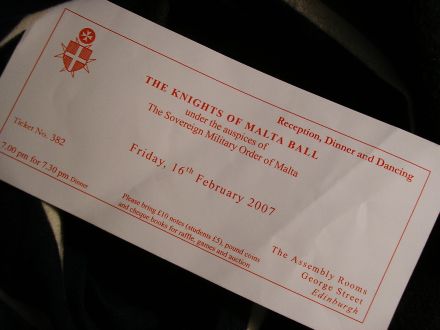
The Many Faces of R.J.E. Bradley
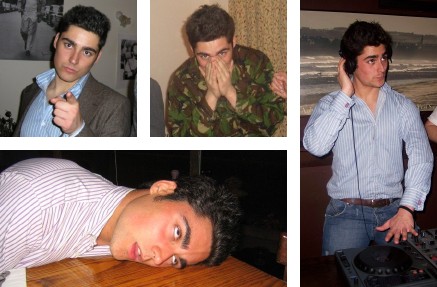
It is one of the wonders of Facebook that with a touch of the button you can find hundreds of photos of your friends. Among my compadres, none have quite the varying range of facial expressions as one R.J.E. Bradley. (Actually, you’ve met him, and his delightful parents, before, remember?). If any of you fear that 1980s-Wall-Street-style decadence has gone the way of the dodo, fear not, for Bradley keeps it alive in St Andrews. He can usually be found doing something outrageous at one of the numerous charity fashion shows, or perhaps enlivening a meeting of the Global Investment Group, or else displaying his wit in some other corner of the auld grey toon.
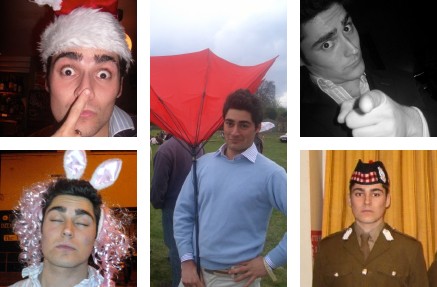
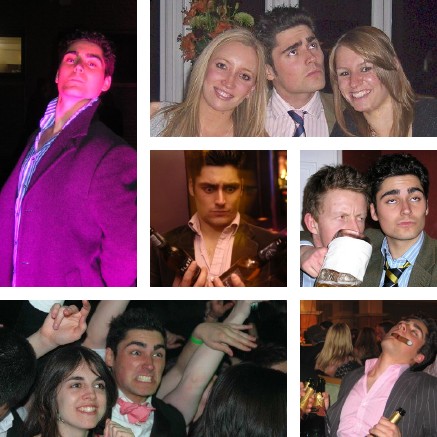
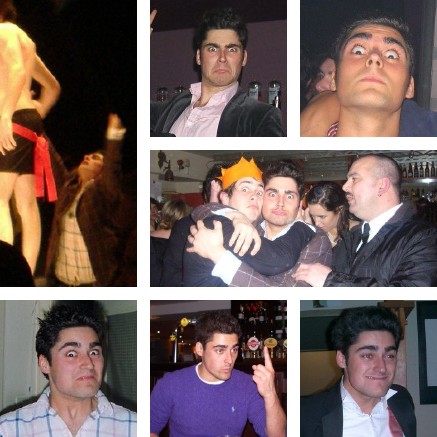
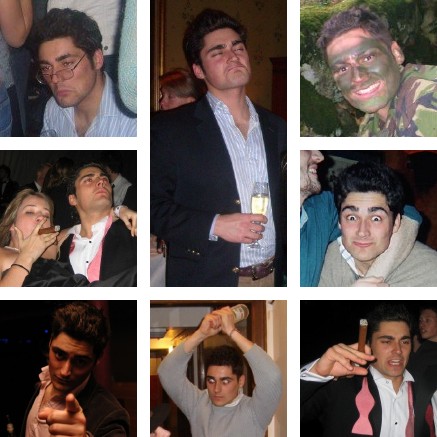
Previously: The Last Sunday
Our Walter, Rest in Peace
I was very saddened to hear this morning of the sudden death of our good and loyal friend, Walter Phelan of Brooklyn. Walter was a good man, with a heart of gold, and a brilliant mind. He taught himself the law, and passed the New York bar exams in the years before at least a year in law school was required (a development which Walter would’ve been the first to tell you was an outright racket). I have no doubt that Walter will be remembered for his numerous small kindnesses. Proud of his favorite Italian bakery, he would hand out loaves of bread from there every Sunday on the sidewalk outside St. Agnes after the 11:00 Tridentine mass. Having a gift for languages, he would often exchange a few kind words with the Polish waitress in her native tongue whenever we had lunch at Bloom’s on Lexington, and he made sure to tutor his young nephew in Latin when he discovered it wasn’t offered at school.
One of the things I liked most about Walter is that he was never afraid to have a good argument. More often than not, he and I found ourselves in agreement, but it was sometimes otherwise, such as with his firm contention that Shakespeare’s plays were actually written by the Earl of Oxford. Nonetheless, he was polite and gracious in dispute, even if outspoken. Still, he was a private man, and as a friend said of him tonight, it would probably take five of his friends who’d never known eachother to piece together the story of his life. Walter heard mass three times a day, and could often be found attending masses at St. Agnes on 43rd Street, at St. Vincent de Paul’s on 24th, and at St. George’s Ukrainian Catholic Church down on 7th Street. Earnest in his desire for the salvation of souls and their eternal repose, he never missed the monthly mass of the New York Purgatorial Society. His friends will miss him very much.
Requiem æternam dona eis, Domine, et lux perpetua luceat eis.
Requiescat in pace. Amen.
The Duke of York in New York
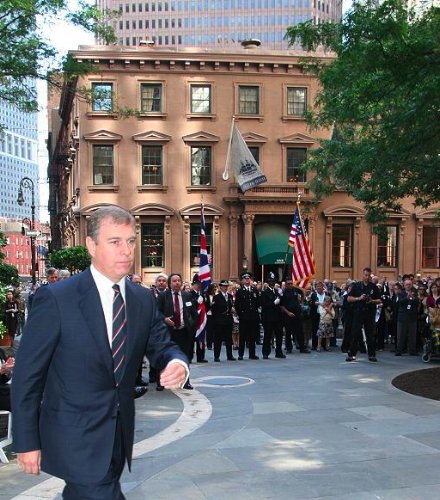
We neglected to mention Prince Andrew’s recent visit to New York in commemoration of the anniversary of the attacks on the World Trade Center. Sixty-seven British subjects died in the September 11, 2001 attacks, and eleven more were non-citizens with British ties. A ceremony was held in Hanover Square, where the British Memorial Garden is being built, followed by a reception at India House, which is located at No. 1 Hanover Square (the brown edifice in the photos above and below). (more…)
The Auld Scotsman
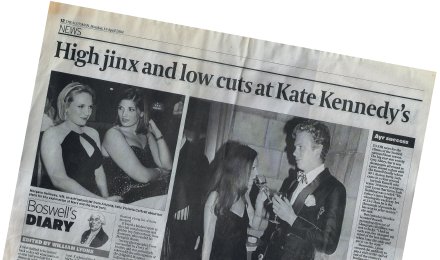
ONE THING WE greatly enjoyed about the Scotsman in its pre-tabloid days was that they often deemed St Andrews social events worthy of coverage in their august pages. It was a source of pride to see ‘the national newspaper’, a respectable broadsheet, covering events at the oldest university in the land (which we are proud to call our own). Naturally, once the conversion to tabloid size was complete, we were rarely heard of again, which was a little saddening. The Scotsman is not what it used to be —a beautiful, well-designed, informative respectable newspaper— but it still manages to print some thoroughly worthwhile articles which is more than can be said of any other Scottish daily. (One need only point out two articles by Prof. Haldane, c.f. here and here, recently posted on this site).
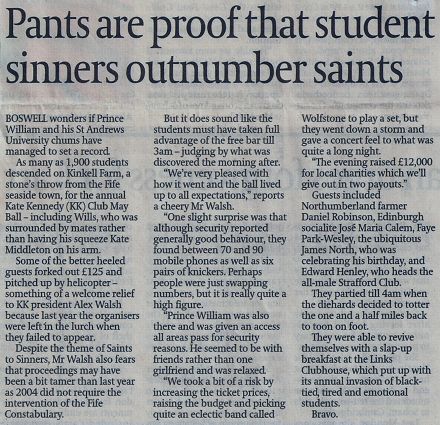
“…when the diehards decided to totter the one and a half miles back to toon on foot.” Sounds familiar.
Admittedly, most of the events covered were organised by the Kate Kennedy Club, which seems to take pride in the sheer vulgarity and tastelessness with which they advertise many of their events. (This is only slightly mitigated by their superb running of the annual Kate Kennedy Procession). Still, we enjoyed the Scotsman‘s coverage and wish it had continued. I only bought the Scotsman on occasion after the switch, but often gave the Common Room’s copy a browse when I lived in St. Salvator’s. (Its Sunday edition, Scotland on Sunday is worth buying for Gerald Warner alone).
Here are a few bits and pieces clipped from the Scotsman for your perusal:
‘Undampened spirits take the party indoors‘ / Lumsden Club garden party moved indoors on account of the rain. (I didn’t go).
‘High jinks and low cuts at Kate Kennedy’s‘ / This covered the Kate Kennedy Procession dinner which takes place at the Old Course Hotel on the evening following the procession. This particular year I was in attendance myself and recall commiserating with Michelle Romero, that charming daughter of Venezuela, about the troubled state of her native land. I was their with our favorite Dane, Sofie von Hauch, and my flatmate, a member of the KK who wishes to remain unnamed on this site. Will Lyons couldn’t make the dinner himself, so he sent ‘K‘ up instead, accompanied by ‘society photographer Z‘ whom I ran into while we were on our way out.
‘Maltesers set ball rolling for charity‘ / The 2004 Knights of Malta Ball, not covered by this website because it did not exist at the time. It was a good time, especially so because I had three friends over from the States. Yalie Adam Brenner was doing his semester abroad at St Andrews at the time, and fellow Old Thorntonian Clara de Soto popped over from Boston College for the weekend with her good friend Katie Cordtz of Atlanta. The four of us together with Michelle Romero and the aforementioned unnamed flatmate of mine piled into a cab and made the hour’s journey to Edinburgh for the soirée. Poor Adam, though. Towards the latter part of the evening Archie Crichton-Stuart, an exceptionally amusing Edinburgh student, and his friend Ramsay forced Adam to consume the significant remnants of a bottle of house red. It all went down swimmingly, but came back up on the cab ride back to Fife. Freddy McNair, who was recently nearly killed by an incompetent gurkha on a training ground, sat at the table next to ours, I recall. (Also, in the lower right-hand corner of the clipping you can spy the face of our good friend Ricky Demarco peering out from an unrelated article).
Previously: Another Broadsheet Bites the Dust
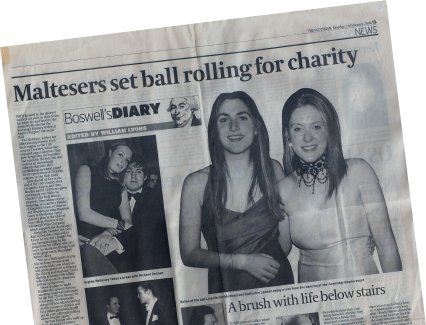
A Book to Remember
Chumley’s Launch Party for ‘Forgotten New York’ Book
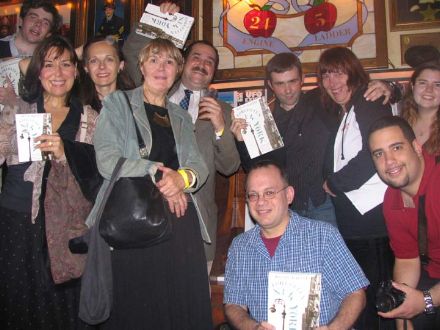
AS I GROW more and more cantankerous, my tolerance for evening trips down to Mannahatta declines, but on occasion there’s an event which would be a crime to miss. Last Thursday, Dawn Eden and I popped down to Chumley’s, the old speakeasy on Bedford Street in the West Village, for the shindig launching Kevin Walsh’s brilliant book, Forgotten New York: Views of a Lost Metropolis. (Kevin reports on the party here). I’ve been following Kevin’s Forgotten New York website for years now, and it has earned an unquestionable rank as one of my favorite sites ever (though, shamefully, I’ve never been on one of his legendary ‘Forgottentours’). The author himself was on hand, naturally, and I also enjoyed meeting a number of very kind people who are as fond of Forgotten New York as I am.
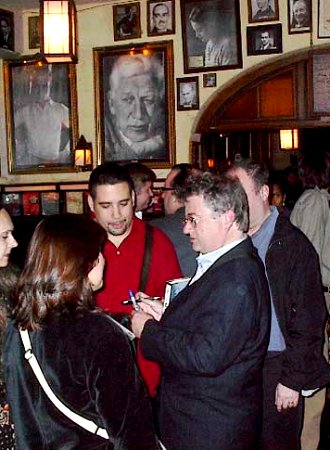
The Man of the Hour himself: Kevin Walsh (in glasses).
While Dawn and Kevin are familiar friends (she even gets a mention in the book’s acknowledgements), I had never before had the privilege of meeting this great chronicler of quinqueboronian miscellany. He is very much like his website: simple and brilliant. Happily, I got my complementary copy of the book personally inscribed, though I quite presumptuously upbraided him for only mentioning Audubon Terrace in passing (c.f. FNY: ‘I Can’t Drive 155’) while I believe it is worth a Forgotten page of its own. (Naturally, I have a post slowly developing on Audubon Terrace, which I believe is one of the most beautiful public spaces in all New York, as well as one of the most underappreciated).
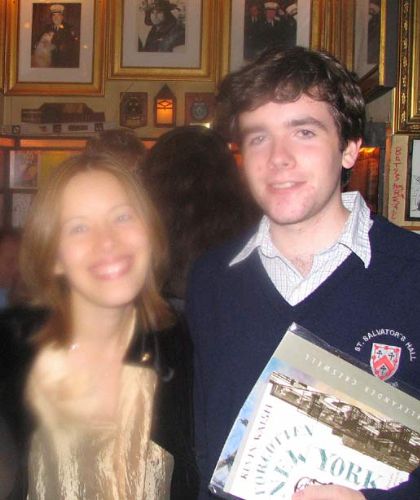
No, the camera isn’t smudged; an angelic haze follows Dawn wherever she goes.
But enough of the fun, how’s the book? Well I love it. It’s emphasis is on breadth rather than depth, since it’d be impossible to reproduce the entire contents of the encyclopedic website in a mid-sized paperback book. I view the book in two regards: first, as a handy basic guide referencing the variety of forgotten, unnoticed, and underappreciated sites around the Five Boroughs; and second, as a good jump-start companion to the more thoroughly informative website.
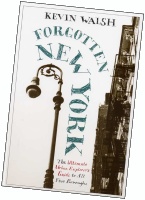
Take, for example, the Lent Riker Smith House out in Queens. Browsing through the book we see the entry on the ‘Lent Riker Smith Homestead’ which gives us two paragraphs of information. Enough to whet the appitite and plant the seed of intrigue, but when we check out the website’s entry on the house we get much, much more… and in color, to boot. I hope readers not yet familiar with the website will use the book as a springboard, but I also hope that we will be gifted with updated editions of the book in years to come, with added features.
Buy the book. Aficionados of forgotten-ny.com will appreciate a version of the familiar in dead-tree form, while the uninitiated will find it extremely useful as a foundation for appreciating Gotham’s numerous nooks and crannies. Kevin Walsh has done a great service to all those who have a love for the Big Apple.
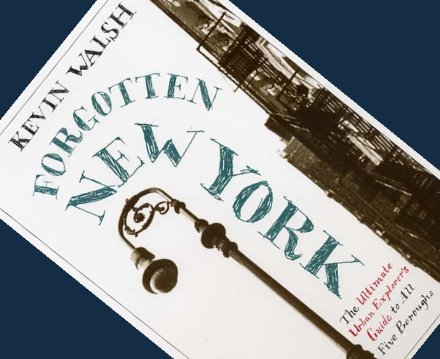
A Picture of Domestic Bliss
I work at my computer in a small room here at home, and Jamie has his in the main room alongside. When we are both tapping away busily, our work is punctuated by his pleas for cups of tea (sometimes he just makes a sort of bleating noise – it’s really quite heart-rending) and by the telephone ringing (annoying – so we often leave the answerphone on and deal with calls later). […]
Later, emerging from a tube station on my way to St Mary’s Church in Chelsea where I was due to give a talk to young engaged couples as part of a Marriage Preparation course, I had a most extraordinary and wonderful experience. There are eight million people in London. And there, walking towards me, was the one person dearest to me in all of them: my husband Jamie. He would never normally be in that part of London, and it is unusual for me to be there too. Neither of us had co-ordinated our activities today, just normal busy schedules for us both…….. He had been at some event at Brompton Oratory followed by lunch and a meeting nearby…..it was a chance in eight million that we should both happen to be in Sloane Square at that precise moment.
Just a little snippet from Joanna Bogle’s new blog, Auntie Joanna Writes. Joanna is an author and journalist, as well as being wife to Jamie Bogle (c.f. balls of ’05 and ’06). You can go on a tour of Catholic England by listening to fourteen of Joanna’s ‘Catholic Heritage’ programs available at this address.
Wedding of the Century
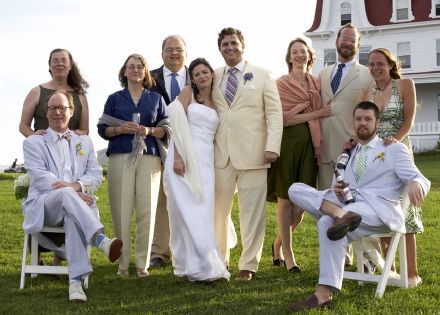
A most hearty congratulations to Mr. and Mrs. James Panero, who were wed recently in a ceremony on Block Island. The Times carried the announcement.
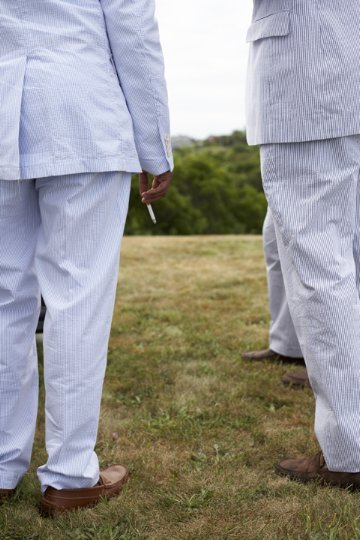
Scientists informed the media that the combined lightness of all the seersucker and linen suits worn at the ceremony raised Block Island four inches out of the water.
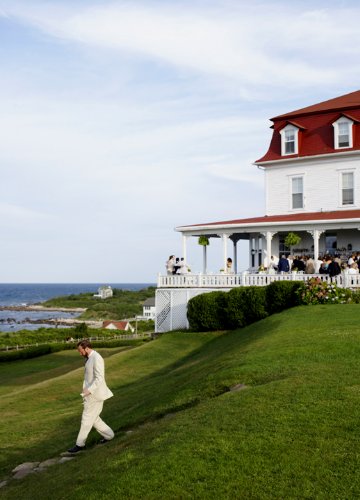
For David Yezzi, poetry is a lonely business…
Champagne Loyalties
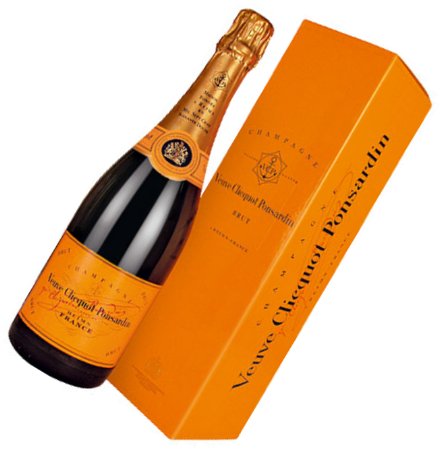
Abigail Hesser once asked me what champagne I preferred and I replied that I’m something of a fan of Veuve-Clicquot. “Veuve-Clicquot? I’ve never heard of it,” saith the Moet et Chandon partisan. Well now the young Miss Hesser (who in less than a year will be the young Mrs. Burke) has revealed herself as a convert to the Veuve cause. “Moet is trite,” she tersely says of her former poison of choice. I sent her a Veuve-Clicquot e-card welcoming her to Veuvianity.
The Red Lion Coffee Shoppe
Or: How Andrew Cusack Became a Tea Drinker
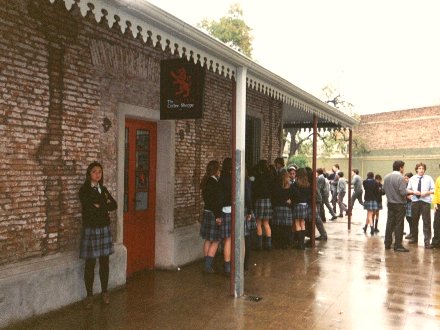
THE HOT SUMMER sun has fled us here in New York, having been replaced by the cooling but somber clouds of rain. My mind can’t help but harken back to an August of just a few years ago when I spent the summer in Argentina. Of course, New York’s summer is Buenos Aires’s winter, but in Argentina winter means prodigious rain and skies of grey, rather than the glorious snows we’re used to in the Big Apple. On the grounds of St. Alban’s College, our happy little school, there was situated the spartan but merry Red Lion Coffee Shoppe.
On many a cold, grey, Argentine August day we would escape the sufferings of education and flee to the Red Lion. There were two points of service at the Red Lion coffee shop: one a window which faced onto the outside (seen above), the other a hole-in-the wall counter which faced onto the little square room which was the shop. It was a simple, sparsely-decorated room with a few chairs and tables, the walls covered with posters lauding South African rugby and New Zealand cricket, and framed prints depicting charming views of other St Alban’s toponyms around the world: the original St. Alban’s in England, St. Alban’s in South Africa, St. Alban’s in Denmark, St. Alban’s just about everywhere. There was only one heater (the Argentines, in their desire to be in all ways like the British, do not heat their buildings properly) mounted onto the side wall opposite the counter and the obvious idea was to sit right next to the heater or else freeze. It was a black moment when one entered the Red Lion only to discover that others – the nerve! – were already situated by the heater. Rest assured, many a rueful glance was exchanged.
Anyhow, while a number of carbonated beverages were on offer, a nice warm cup of tea was much preferred to a cold, refrigerated soda. Tea at the Red Lion, which was invariably Green Hills, was accompanied by chocolate, usually fulfilled by a packet of M&M’s, but occasionally I went for Rhodesia bars which I confess I only ever bought because of their name. (Incidentally, I took a Rhodesia bar home and when I had a fetching young tutor at St Andrews who was one of the last Rhodesians to be born, I gave it to her as a gift at our last tutorial).
I had never been a regular tea drinker before then and am very glad that I acquired the happy habit; it is one which has stood me well throughout the ages. What better companion in Scotland, for example, while reading as the grey tempest of the Caledonian climate brews outside, than a nice cup of warm brew inside? And of course tea need not be a solitary joy. When I think of the hours wasted away in after-rosary cups of tea on weekday afternoons in St Andrews! It would bring scandal to some. Indeed one cold Scottish afternoon the hours of cups of tea gave way to two bottles of port, and then a raid by a gaggle of ne’erdowells on my secret whiskey reserve! (Duly recounted herein).
At any rate, I believe it to be one of summer’s chief deficiencies that it is too hot for the proper, frequent enjoyment of tea, and so I rather look forward to the coming fall and winter seasons. Nestled in a comfy chair with a nice cup of tea and a good book; could there be pleasures more sublime?
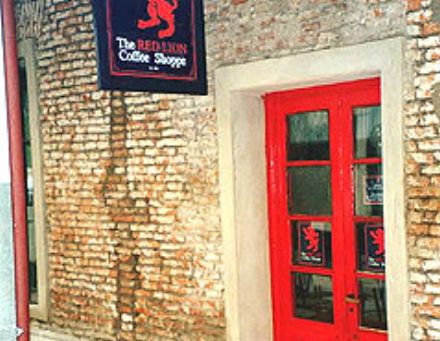
Search
Instagram: @andcusack
Click here for my Instagram photos.Most Recent Posts
- Teutonic Takeover March 10, 2025
- Katalin Bánffy-Jelen, R.I.P. March 3, 2025
- Substack Cusackiensis March 3, 2025
- In the Courts of the Lord February 13, 2025
- American Exuberant February 10, 2025
Most Recent Comments
Book Wishlist
Monthly Archives
Categories

